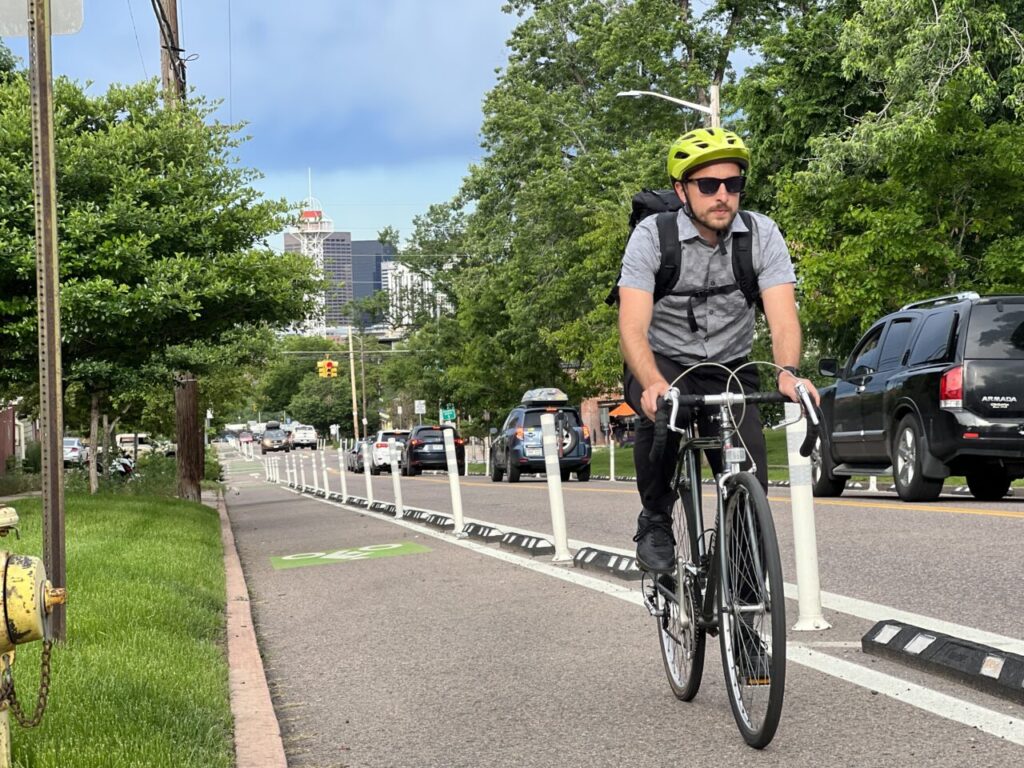By Allen Cowgill
At a recent small ceremony on the side of West 46th Avenue next to Rocky Mountain Lake Park, Mayor Michael Hancock unveiled a sign marking 125 new miles of bikeways for the Denver bike network.
The sign marks a major milestone for the Denver Department of Transportation and Infrastructure (DOTI), with an aggressive buildout of bikeways throughout Denver, though some residents feel the new bikeways don’t go far enough for comfort and safety.
The goal of 125 new miles of bike lanes was set in 2018 by the mayor with the goal of bringing high-comfort bike facilities within a quarter mile of where more Denverites live “to connect riders of all abilities to the places they want to go.”
At the event, Hancock said that “this is not a victory lap, we are proud of the milestone we have reached, but we’ve got to keep going.”
When asked about Denver being a growing city and the importance of providing numerous options for people traveling, the mayor said, “It’s the only option. The old single-mode transportation system in Denver no longer applies. We have grown exponentially over the last decade.”
“We have to be a more multimodal city, and we have to have the infrastructure that supports it,” Hancock continued. “The various types of bike lanes we have … are extremely important for folks to feel safe in riding bikes and using different modes around the city whether they are on scooters (or bikes), we have to continue to invest in transit. We don’t have any other option.”
DOTI actually exceeded the mayor’s goal, building out 137 miles of bikeways since 2018. Though technically the original goal was for bike lanes, it has since been expanded to include neighborhood bikeways, or bike facilities that are not actual bike lanes, but routes that share the road with drivers on low-volume streets.

They use sharrows, traffic circles, diverters, and paint and post bulb-outs to calm traffic for people who bike, and have been a popular option for planners in north Denver. Of those new bikeway miles, 24 miles were painted bike lanes, 45 miles were buffered bike lanes (bike lanes with a painted space between the bike lane and vehicle travel lane), 23 miles were protected bike lanes, 34 miles were neighborhood bike lanes, and 11 miles were shared-use paths and trails.
“As we continue to build out our bike and multimodal network, we are creating a more sustainable alternative to driving that’s safer, enjoyable and better for our health and our environment,” DOTI Executive Director Adam Phipps said.
Layton Hill, a resident of the Highland neighborhood in North Denver, has lived in Denver for 10 years and has noticed a change in the types of people riding bikes in Denver.
“I used to see a lot more people out primarily for fitness, and now my most common bike trip is to daycare, and I’m seeing lots and lots of other families with children on their bicycles going about their day,” Hill said.
Hill said the new bike lanes aren’t perfect, but they do make it easier for him to get around. Most of the time, the streets are comfortable for him, but 10% of the time, there will be a driver that will get too close to him while he has his daughter on the back of his bike.
“They have made it better to get around,” Hill said. “I would like to see more truly prioritized lanes for people not in cars. I think having more diverters in place on just the few streets that are designated as bike lanes would be good. It would still allow neighbors to access their houses of course, and small businesses to receive deliveries. Everyone retains access to their curb, but it would just make those streets just a little bit less highly trafficked, and make them a little more comfortable for people not in cars.”
The diverters that Hill referenced are modal filters that allow bikes and pedestrians to go through an intersection, but force drivers of cars to turn, limiting the amount of vehicle traffic on the street.
Currently in North Denver there are only two diverters: West 35th Avenue and Irving Street, and West 41st Avenue and Pecos Street. The protected bike lanes that have been installed in places like West 23rd Avenue and West 17th Avenue have been impactful in generating increased bike and scooter traffic. Recent research from Ride Report, an organization that has been working with the city to collect data, shows that the West 17th Avenue protected bike lane had a nearly eightfold increase in shared bike and scooter ridership between 2019 and 2023 after the protected bike lanes and new painted bike lanes were installed.
Over 57,000 trips using shared bikes and scooters have been taken on West 17th Avenue alone since the new bike lanes were completed.
Allen Cowgill is the City Council District 1 Appointee for the Denver DOTI Advisory Board.

Be the first to comment